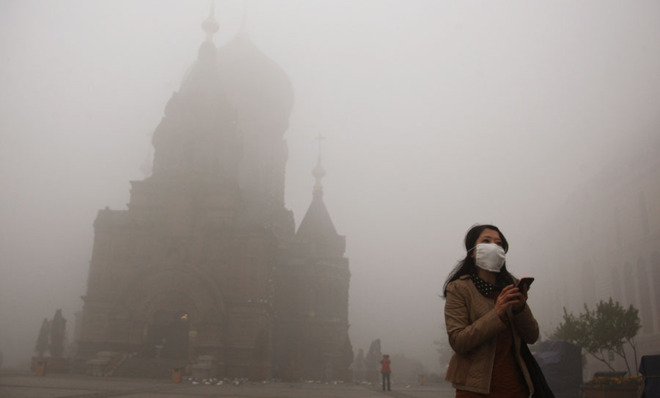8 scary facts about China's 'smogpocalypse'
The smog is thick as soup in one of the country's most populated cities

The northern Chinese city of Harbin, population 10 million, is in the midst of a "smog emergency" this week, with air pollution so thick government officials have issued a "red alert," closed public schools and urged children, the elderly, and people with respiratory problems to stay in doors.
Visibility in the city, famous for its international Ice and Snow Sculpture Festival, dropped to less than 33 feet Tuesday, confusing traffic and causing the city to shut down its international airport and a major highway to avoid additional hazards on top of the already scary health threat of soup-thick air pollution.
The air's levels of PM2.5 — the fine air born particulate matter that poses a great risk to human health — reached 40 times what the World Health Organization says is tolerable on Tuesday. It was the highest measure since the country started releasing data in 2012.
The Week
Escape your echo chamber. Get the facts behind the news, plus analysis from multiple perspectives.

Sign up for The Week's Free Newsletters
From our morning news briefing to a weekly Good News Newsletter, get the best of The Week delivered directly to your inbox.
From our morning news briefing to a weekly Good News Newsletter, get the best of The Week delivered directly to your inbox.
Harbin even beat records logged in Beijing in January, when PM2.5 levels topped 993 micrograms per cubic meter (the WHO's red line is 25), drawing international attention and leading to a wave of new measures aimed at taming pollution. "Last month China announced plans to start listing its top ten most air-polluted cities every month in the hopes that national humiliation will push positive environmental action," says CNN. Officials also announced plans to block construction on new plants in three heavily polluted regions.
But for now, China's air quality problem — driven by the hundreds of smog-coughing coal-fired plants which have powered the last decade of unstoppable industrial growth for the nation — is still getting worse. China's state-owned media blames Harbin's current smog-attack on the area's public heating system, which requires booting up extra coal-fired power plants in mid-October as the weather starts to turn chilly. Officials also blamed "a lack of wind and farmers burning crop stalk after their autumn harvest," says CNN.
Here, a few facts about China's situation:
1. China burns nearly half the world's coal, reaching 3.8 billion tons in 2011.
A free daily email with the biggest news stories of the day – and the best features from TheWeek.com
2. The highest PM2.5 level ever recorded in traffic-clogged New York in a 24-hour period was 29 micrograms per cubic meter, while the highest for Los Angeles — a city known for its beautiful, smog-enhanced sunsets — was 43. Readings in Harbin this weekend topped 1,000.
3. Researchers at Greenpeace estimate that Beijing alone suffered 2,589 deaths because of PM2.5 air pollution in 2012.
4. Beijing also lost an estimated $328 million in economic costs due to pollution in the same year.
5. PM2.5 is considered the most dangerous type of air born pollution because the particles are so fine — about 1/30 the average width of a human hair — that they get lodged deep in people's lungs. The soluble part of those particles enter the blood stream, while the insoluble part accumulates in the lungs, together leading to cardiotoxicity and a range of heart problems. Elderly folks, children, and pregnant women are most at risk.
6. PM2.5 can include heavy metal and PAH pollutants as well, which can cause placental blood toxicity "that leads to direct harm to fetus, intrauterine growth retardation and low birth weight of babies," especially when the mother is exposed during the first month of pregnancy, says Green Peace.
7. Though much of the PM2.5 comes from power plants, it's also coughed out in the exhaust of motor vehicles, and wood burning home heating systems.
8. Though China is the worst offender right now, heavy air pollution has long been a side-effect of strong economic growth. China's "environmental problems do have historical parallels," says The Economist. "With the exception of Chongqing, the largest municipality, most Chinese cities are no more polluted than Japan’s were in 1960." That doesn't bode well for the future of other developing nations.
Carmel Lobello is the business editor at TheWeek.com. Previously, she was an editor at DeathandTaxesMag.com.
-
 Why it’s important to shop around for a mortgage and what to look for
Why it’s important to shop around for a mortgage and what to look forThe Explainer You can save big by comparing different mortgage offers
-
 4 ways to save on rising health care costs
4 ways to save on rising health care costsThe Explainer Health care expenses are part of an overall increase in the cost of living for Americans
-
 How to financially prepare for divorce
How to financially prepare for divorceThe Explainer Facing ‘irreconcilable differences’ does not have to be financially devastating